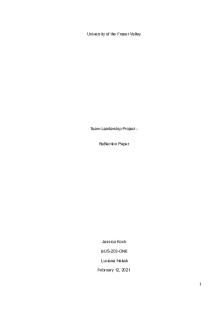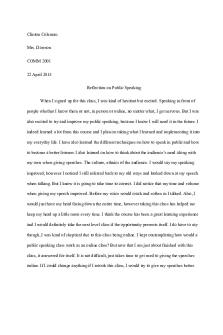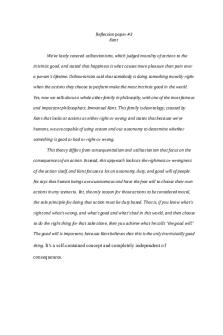Essay 5 Case Study Reflection Paper PDF

| Title | Essay 5 Case Study Reflection Paper |
|---|---|
| Author | Elizabeth Rubin |
| Course | Assessment, Diagnosis and Remediation of Reading Disabilities, Grades 1-6 |
| Institution | Touro College |
| Pages | 7 |
| File Size | 79.6 KB |
| File Type | |
| Total Downloads | 42 |
| Total Views | 152 |
Summary
Case Study...
Description
Running head: CASE STUDY REFLECTION PAPER
Case Study Reflection Paper Elizabeth Rubin Touro Graduate School of Education
While conducting and observing an individual who displayed characteristics of having a
Running head: CASE STUDY REFLECTION PAPER 1
stuttering disorder, I have gained a new perspective on students who display behaviors that affect their reading and language fluency abilities. The child that I chose to assess was a 6 year old boy. The characteristics that he displayed were most commonly associated with a stuttering disorder. The mother was aware and was additionally aware of the impending struggles that the student was facing in school. Since the student was facing difficulties with his fluency and language, this caused a delay in his reading abilities. By studying this student, I came to realize that every student truly acquires information differently from their peers. Students who need support in their literacy strive on differentiated instruction and accommodations to help them be successful with the content. Differentiating instruction for students so that the materials and instruction is appropriate for their level but they are still acquiring the same skills as their peers is vital in students with disabilities’ success. For this particular student, assignments that had him speak out loud individually in front of the class was a true hardship for him. His frustrations overwhelmed him and he would display characteristics that would hinder his performance with the material. In order to best serve this student but not impede upon the set curriculum, the student’s educator may create an alternative teaching method for the student in order to effectively assess his skills. However, according to The Stuttering Foundation, there are specific tips for educators to take into consideration when working with students who have a speech impairment - specifically a stutter. According to Dr. Scott, it is important when interacting and instructing these students that you as the educator “expect the same quality and quantity of work from the student who stutters as the one who doesn’t.” However, it is important as an educator to be patient with this population of students and encourage the students to participate in the activities throughout the day. By doing so, this allows the student to be more exposed to fluency and language
Running head: CASE STUDY REFLECTION PAPER 2
experiences. Through the observations, assessments, and evaluations of this particular student, I have gained new perspectives on strategies that aided in discovering new resources to utilize to instruct literacy, specifically for students with reading impairments. An extremely important aspect of teaching literacy, specifically with students with reading impairments, is acknowledging the connection between reading comprehension and speech development. According to Torreno (2011), this is a common need of students with speech impairments, as “some students with severe speech impairments will have deficits with the analytical skills required to read and write.” In order to best meet the needs of these students, educators should incorporate individual instruction to focus on the deficits this population of students display (Torreno, 2011). Through the process of evaluating the child, I realized that these components are essential to guide him through his academic career. By having his educators implement more individualized, differentiated coursework, his educators will have the opportunity to target more of his specific needs that are in relation to his speech impairment. In order to best target his needs, other strategies can be implemented as well. For instance, Torreno (2011), offers more insight on the strategies that can be incorporated into instruction. In order to promote accurate fluency, educators are encouraged to model correct language and productions of sound. By modeling the correct characteristics, students will receive more exposure to practice these skills in other contexts. By conducting the assessment and then evaluating the results of the child, it truly opened my eyes to the many important components that go into instructing a student. However, I have come to the realization that in the realm of education, every student acquires and applies information different from their peers. This can be applied to educators as well - our teaching
Running head: CASE STUDY REFLECTION PAPER 3
methods may be effective for one class, while another class may not be responding well to the instruction. According to McCarthy (2014), the ways in which we design and create our lesson plans should abide by these ideals. We need to acknowledge every student’s needs and strengths in order to further develop the knowledge they are obtaining. In order to accomplish this, we can create what McCarthy (2014) describes as “learning profiles.” When instructors implement this strategy, we can understand our students’ paths to learning as well as be more efficient in ensuring their success (McCarthy, 2014). When educators have access to an “in-depth understanding for how our students learn, there is a major impact on diagnosing student needs and planning effective supports” (McCarthy, 2014). When conducting the case study on the child, I was able to gain a deeper understanding of the implications that cause his impairments as well as the tools and resources that, together, help him succeed. Through this case study, I have truly grasped the ideal of not placing students in a “one size fits all” category as each student acquires knowledge in various methods. This case study allowed me to have the opportunity to evaluate a student who does not acquire information or express their learning in a typical manner. Because of this, the use of differentiated instruction and other strategies is what the student needs to be successful alongside his peers. Differentiating the methods in which you instruct can be a vital tool in helping these students succeed in and out of the classroom. Placing students in a classroom environment in which every aspect of the class instruction, atmosphere, and material is the same, places students’ at risk. By following the ideology of individuality in learning, students and instructors become more aware of the ways in which they acquire knowledge and how it should be instructed. Leading up to the implication of the case study, the courses that I partook in assisted in my conduction of the assessments and the protocols that accompany it. Touro offered courses
Running head: CASE STUDY REFLECTION PAPER 4
that centered around serving the best instruction to students with disabilities while still creating a wholesome class environment. Through my fieldwork experiences and student teaching placements, I gained real-world insight on how specific classrooms should be executed. My general education placement was an inclusive classroom. There were 22 general education students with three students with special needs that ranged in academic levels. The opportunity to be apart of the classroom routine and observe the teacher differentiate the instruction for these students was truly remarkable to witness. The opportunity provided many strategies, insight from other professionals, and resources that were used to better serve every student’s needs in and out of the classroom. For instance, my cooperating teacher commonly seeked out assistance and support from other professionals in the school when she was concerned about her own effectiveness. I believe this is an extremely humbling tactic to employ as you could truly see that she cared deeply about her students success with the material. I hope to employ these ideals into my future teaching as it truly benefited the students and teachers alike. If I were conducting and writing my case study currently, I would change the outlook I had going into the assessment. When choosing a student, I was seeking out families that I knew that had instances or queries about their child’s academic or language development. If this assessment was being conducted in the present, I would not start the assessment with the mindset of pinpointing a disorder or impairment, rather, just let the child express their knowledge to the best of their abilities and gain my own opinion after the fact. I believe this would have changed the atmosphere of the assessment as well as the overall tone that the assessment carried. This assignment was a great opportunity to gain insight on the implications of reading disorders or impairments on a student’s overall learning. It truly opened my eyes to the many ways in which children develop knowledge, skills, and strategies to help them grasp a concept. In
Running head: CASE STUDY REFLECTION PAPER 5
addition, this case study allowed me to have the opportunity to clearly see how beneficial and advantageous differentiated instruction and individualized instruction may be for students who face reading disorders, specifically speech impairments.
Reference List
McCarthy, J. (2014, August 13). How Learning Profiles Can Strengthen Your Teaching. Retrieved from https://www.edutopia.org/blog/learning-profiles-john-mccarthy Scott, L. 8 Tips For Teachers. Retrieved from https://www.stutteringhelp.org/8-tips-teachers Torreno, S. (2011, April 5). Strategies for Teaching Students with Speech Impairments. Retrieved from
Running head: CASE STUDY REFLECTION PAPER 6
https://www.brighthubeducation.com/special-ed-speech-disorders/113025-strategies-used -to-teach-students-with-speech-impairments/...
Similar Free PDFs

Reflection paper 1 - Essay
- 3 Pages

Reflection Paper chapter 5
- 1 Pages

Sysco Case Study Reflection
- 3 Pages

5-Paragraph Reflection Essay
- 3 Pages

Case 5 - Case study 5
- 2 Pages

Reflection Paper
- 2 Pages

Reflection Paper
- 4 Pages

Reflection Paper
- 2 Pages

Case study response essay.
- 7 Pages

Essay, McDonald’s Case Study
- 17 Pages

Reflection paper
- 3 Pages

Case study essay - final
- 17 Pages

Case study essay
- 11 Pages

PSY2013 Essay case study
- 10 Pages

Case 5 - Valve - Case Study
- 3 Pages
Popular Institutions
- Tinajero National High School - Annex
- Politeknik Caltex Riau
- Yokohama City University
- SGT University
- University of Al-Qadisiyah
- Divine Word College of Vigan
- Techniek College Rotterdam
- Universidade de Santiago
- Universiti Teknologi MARA Cawangan Johor Kampus Pasir Gudang
- Poltekkes Kemenkes Yogyakarta
- Baguio City National High School
- Colegio san marcos
- preparatoria uno
- Centro de Bachillerato Tecnológico Industrial y de Servicios No. 107
- Dalian Maritime University
- Quang Trung Secondary School
- Colegio Tecnológico en Informática
- Corporación Regional de Educación Superior
- Grupo CEDVA
- Dar Al Uloom University
- Centro de Estudios Preuniversitarios de la Universidad Nacional de Ingeniería
- 上智大学
- Aakash International School, Nuna Majara
- San Felipe Neri Catholic School
- Kang Chiao International School - New Taipei City
- Misamis Occidental National High School
- Institución Educativa Escuela Normal Juan Ladrilleros
- Kolehiyo ng Pantukan
- Batanes State College
- Instituto Continental
- Sekolah Menengah Kejuruan Kesehatan Kaltara (Tarakan)
- Colegio de La Inmaculada Concepcion - Cebu
